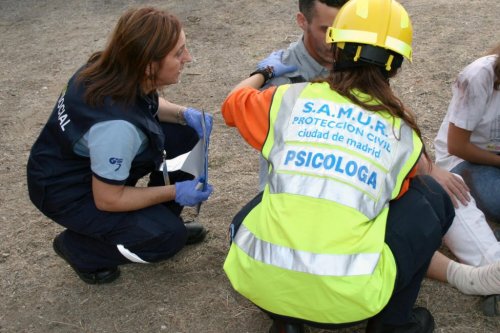Do You Know What Debriefing Is?


Written and verified by the psychologist Gema Sánchez Cuevas
Psychological debriefing is a quick intervention that takes place the first days after a traumatic event. This event can be a natural catastrophe (earthquake, flood, etc.), a car accident, etc.
In a debriefing, a group of colleagues or people who have experienced an event in a similar way come together. The objective is to exercise intragroup support among those who have been involved in the same situation under similar conditions.
The goal is to create a space where group members can express their feelings, thoughts, and reactions in a safe space. Doing so helps prevent future mental disorders.
In addition, these people meet to rid themselves of the emotional burden that builds up after a traumatic event. A psychologist leads these meetings and the group members tell the story of what happened to them during the event.
Psychologists designed debriefing as a technique to help people deal with potentially traumatic events. Emergency professionals consider this tool a great help in avoiding the exacerbation of psychological symptoms.

Professionals also suffer
Emergency professionals are humans too. They also suffer and need help sometimes. They’re the forgotten ones. These professionals have a high risk of suffering psychological damage because of what they do. Hence, it’s especially important that they receive immediate assistance after experiencing traumatic situations.
They’re often assigned tasks regardless of their age, training, skills, or experience. This can make symptoms of acute stress emerge. At other times, the same professional may not even realize that they’re in over their heads.
Intervention during a catastrophe doesn’t follow a fixed or predictable schedule. Emergency situations are constantly changing, which means the professional must be able to handle diverse and urgent circumstances.
Professionals require numerous resources to do their job. In emergency situations, they may not be able to go by the book. The professional must address the situation’s unique characteristics and go from there.
The symptoms an emergency professional experiences
An emergency professional can experience many symptoms after a catastrophe. Physiologically, the professional who’s working under pressure may deal with fatigue, nausea, chills, and shortness of breath.
They’ll surely be alert and vigilant at a cognitive level. However, they may have negative thoughts and not know how to stop them. The mental response is a combination of fear, anxiety, irritation, and even emotional shock.
At the motor level, a professional may be affected by the inability to rest, accelerated speech, and may begin screaming during normal conversation. To prevent these symptoms from worsening, psychologists use debriefing. This is why it’s an exceptional tool.
Why is it important to recognize your own stress and act on it?
The effects of stress on emergency professionals can be truly harmful. Let’s take a look at some of these effects:
At work:
- Impaired quality of work.
- Increased absenteeism.
- Less engagement.
- More conflicts with colleagues (with both superiors and subordinates).
At home:
- Conflicts with their partner and other relatives.
- Negative comments and telling stories your loved ones aren’t ready to hear.
- Isolation.

How to start the debriefing process
The help emergency professionals get shouldn’t end with intervention. This means they should also be helped after their shift is over. Coping with negative experiences should be an explicit, organized process.
On the other hand, group support and emotional relief meetings have both followers and detractors. Many organizations use these techniques to help people deal with their emotions after experiencing catastrophes.
These meetings have a set of rules. An expert leads these meetings and all participants tell their side of things and how the event affected them. In addition, they also include the cognitive and emotional reactions experienced during the event.
Once the shift is over or the rescue is complete, a leader should encourage a relaxed meeting with all those who participated in the event. In this meeting, participants should be encouraged to:
- Narrate their experience.
- Talk about their feelings.
The leader of the activity should:
- Let the participants know the symptoms they may experience or suffer in the coming days.
- Tell them how to act on these symptoms.

The debriefing stages
The debriefing process isn’t improvised. Rather, it’s structured according to the following stages:
- The objectives are explained.
- Each member introduces themselves and explains what happened.
- The members describe what they saw, heard, and the thoughts they had.
- Each member describes their reactions. The facilitator asks each member to focus on the worst thing they experienced.
- Each member comments on the stress responses they experienced immediately after the incident and the ones they’re currently experiencing.
- The facilitator lets the participants know these reactions are normal and teaches them coping mechanisms.
- The facilitator clears any doubts. This is the opportunity to say whatever was left unsaid and the facilitator offers additional support.
After debriefing, emergency professionals may still have symptoms. These symptoms include not sleeping, self-criticism about how they acted, feeling misunderstood, etc.
As we’ve seen, the stress that emerges after emergency situations can be really difficult to manage. This is why debriefing should take place between the first 24 to 72 hours after the critical incident. The goal of debriefing is to put suffering into words, give a structure to the event, and relieve the stress the participants are experiencing. The expert facilitates this in a structured way.
In conclusion, we should learn to understand and handle the normal reactions that come about after a traumatic event. We should do this in a place where we feel safe, accompanied, and guided therapeutically in the hopes of feeling better.
Psychological debriefing is a quick intervention that takes place the first days after a traumatic event. This event can be a natural catastrophe (earthquake, flood, etc.), a car accident, etc.
In a debriefing, a group of colleagues or people who have experienced an event in a similar way come together. The objective is to exercise intragroup support among those who have been involved in the same situation under similar conditions.
The goal is to create a space where group members can express their feelings, thoughts, and reactions in a safe space. Doing so helps prevent future mental disorders.
In addition, these people meet to rid themselves of the emotional burden that builds up after a traumatic event. A psychologist leads these meetings and the group members tell the story of what happened to them during the event.
Psychologists designed debriefing as a technique to help people deal with potentially traumatic events. Emergency professionals consider this tool a great help in avoiding the exacerbation of psychological symptoms.

Professionals also suffer
Emergency professionals are humans too. They also suffer and need help sometimes. They’re the forgotten ones. These professionals have a high risk of suffering psychological damage because of what they do. Hence, it’s especially important that they receive immediate assistance after experiencing traumatic situations.
They’re often assigned tasks regardless of their age, training, skills, or experience. This can make symptoms of acute stress emerge. At other times, the same professional may not even realize that they’re in over their heads.
Intervention during a catastrophe doesn’t follow a fixed or predictable schedule. Emergency situations are constantly changing, which means the professional must be able to handle diverse and urgent circumstances.
Professionals require numerous resources to do their job. In emergency situations, they may not be able to go by the book. The professional must address the situation’s unique characteristics and go from there.
The symptoms an emergency professional experiences
An emergency professional can experience many symptoms after a catastrophe. Physiologically, the professional who’s working under pressure may deal with fatigue, nausea, chills, and shortness of breath.
They’ll surely be alert and vigilant at a cognitive level. However, they may have negative thoughts and not know how to stop them. The mental response is a combination of fear, anxiety, irritation, and even emotional shock.
At the motor level, a professional may be affected by the inability to rest, accelerated speech, and may begin screaming during normal conversation. To prevent these symptoms from worsening, psychologists use debriefing. This is why it’s an exceptional tool.
Why is it important to recognize your own stress and act on it?
The effects of stress on emergency professionals can be truly harmful. Let’s take a look at some of these effects:
At work:
- Impaired quality of work.
- Increased absenteeism.
- Less engagement.
- More conflicts with colleagues (with both superiors and subordinates).
At home:
- Conflicts with their partner and other relatives.
- Negative comments and telling stories your loved ones aren’t ready to hear.
- Isolation.

How to start the debriefing process
The help emergency professionals get shouldn’t end with intervention. This means they should also be helped after their shift is over. Coping with negative experiences should be an explicit, organized process.
On the other hand, group support and emotional relief meetings have both followers and detractors. Many organizations use these techniques to help people deal with their emotions after experiencing catastrophes.
These meetings have a set of rules. An expert leads these meetings and all participants tell their side of things and how the event affected them. In addition, they also include the cognitive and emotional reactions experienced during the event.
Once the shift is over or the rescue is complete, a leader should encourage a relaxed meeting with all those who participated in the event. In this meeting, participants should be encouraged to:
- Narrate their experience.
- Talk about their feelings.
The leader of the activity should:
- Let the participants know the symptoms they may experience or suffer in the coming days.
- Tell them how to act on these symptoms.

The debriefing stages
The debriefing process isn’t improvised. Rather, it’s structured according to the following stages:
- The objectives are explained.
- Each member introduces themselves and explains what happened.
- The members describe what they saw, heard, and the thoughts they had.
- Each member describes their reactions. The facilitator asks each member to focus on the worst thing they experienced.
- Each member comments on the stress responses they experienced immediately after the incident and the ones they’re currently experiencing.
- The facilitator lets the participants know these reactions are normal and teaches them coping mechanisms.
- The facilitator clears any doubts. This is the opportunity to say whatever was left unsaid and the facilitator offers additional support.
After debriefing, emergency professionals may still have symptoms. These symptoms include not sleeping, self-criticism about how they acted, feeling misunderstood, etc.
As we’ve seen, the stress that emerges after emergency situations can be really difficult to manage. This is why debriefing should take place between the first 24 to 72 hours after the critical incident. The goal of debriefing is to put suffering into words, give a structure to the event, and relieve the stress the participants are experiencing. The expert facilitates this in a structured way.
In conclusion, we should learn to understand and handle the normal reactions that come about after a traumatic event. We should do this in a place where we feel safe, accompanied, and guided therapeutically in the hopes of feeling better.
All cited sources were thoroughly reviewed by our team to ensure their quality, reliability, currency, and validity. The bibliography of this article was considered reliable and of academic or scientific accuracy.
Costa Marcé, A. & Gracia Blanco, M. de. (2002). Debriefing y tría psicológica en intervención, en crisis: una revisión. Debriefing and Psychological Triage in crisis intervention: a review, 23(5), 198-208.
Echeburúa, E. & Corral Gargallo, P. de. (2007). Intervención en crisis en víctimas de sucesos traumáticos: ¿cuándo, cómo y para qué? Crisis intervention in victims of traumatic events: when, how and what for?, 15(3), 373-387.
This text is provided for informational purposes only and does not replace consultation with a professional. If in doubt, consult your specialist.







